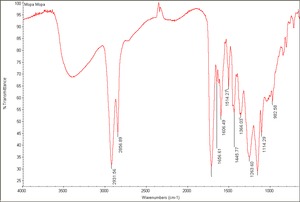Difference between revisions of "Mopa-mopa"
Jump to navigation
Jump to search
| Line 1: | Line 1: | ||
[[[SliderGallery rightalign|Mopa Mopa.TIF~FTIR(MFA)]]] | [[[SliderGallery rightalign|Mopa Mopa.TIF~FTIR(MFA)]]] | ||
| + | == Description == | ||
| + | |||
| + | A native South American phenolic resin commonly called mopa mopa was used for many centuries in two cultural contexts, by artisans in the region of Pasto, Colombia (where it is still used), and by the Inka in Peru, where it was used to decorate ceremonial drinking cups known as qeros. It was softened to a rubbery state by heating in water, mixed with colorants, stretched into thin layers and applied as inlay to decorate wooden surfaces of various kinds of objects. The resin comes from trees of the genus Elaeagia, which grows in mountainous regions of western South America from Colombia to Ecuador. Botanical specimens from the two species that are the most likely sources of mopa mopa, Elaeagia pastoensis and Elaeagia utilis | ||
| + | |||
| + | ==Resources and Citations== | ||
| + | * Richard Newman, Emily Kaplan and Michele Derrick, MOPA MOPA: SCIENTIFIC ANALYSIS AND HISTORY OF AN UNUSUAL SOUTH AMERICAN RESIN USED BY THE INKA AND ARTISANS IN PASTO, COLOMBIA, Journal of the American Institute for Conservation, August 1, 2015, Vol.54, p. 123-48. | ||
| − | |||
| − | |||
[[Category:Materials database]] | [[Category:Materials database]] | ||
Latest revision as of 08:31, 19 October 2022
Description
A native South American phenolic resin commonly called mopa mopa was used for many centuries in two cultural contexts, by artisans in the region of Pasto, Colombia (where it is still used), and by the Inka in Peru, where it was used to decorate ceremonial drinking cups known as qeros. It was softened to a rubbery state by heating in water, mixed with colorants, stretched into thin layers and applied as inlay to decorate wooden surfaces of various kinds of objects. The resin comes from trees of the genus Elaeagia, which grows in mountainous regions of western South America from Colombia to Ecuador. Botanical specimens from the two species that are the most likely sources of mopa mopa, Elaeagia pastoensis and Elaeagia utilis
Resources and Citations
- Richard Newman, Emily Kaplan and Michele Derrick, MOPA MOPA: SCIENTIFIC ANALYSIS AND HISTORY OF AN UNUSUAL SOUTH AMERICAN RESIN USED BY THE INKA AND ARTISANS IN PASTO, COLOMBIA, Journal of the American Institute for Conservation, August 1, 2015, Vol.54, p. 123-48.
